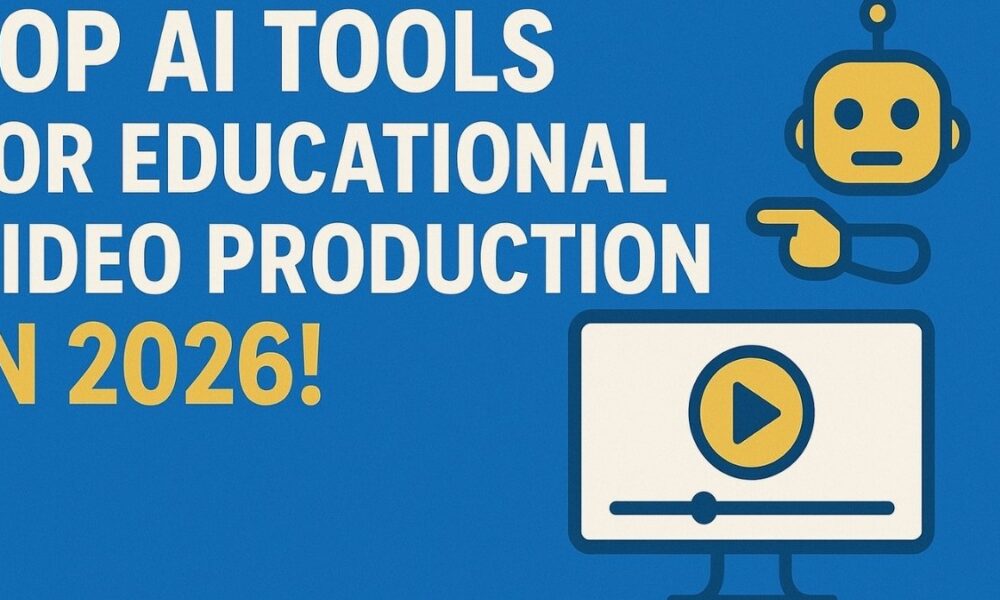AI Technology
Top AI Tools for Educational Video Production in 2026!

Education is undergoing a major transformation, and one of the key drivers behind this change is Artificial Intelligence (AI). As digital learning becomes the backbone of schools, universities, and professional training, the demand for high-quality educational videos has increased significantly. By 2026, AI will not only streamline the process of video creation but also personalize and optimize educational content for learners worldwide.
This article explores how AI-powered tools are shaping educational video production in 2026, why they are essential, and the best ways educators, institutions, and businesses can use them.
Why AI is Crucial for Educational Video Production
- Scalability: Institutions can produce hundreds of video lessons in less time.
- Cost Efficiency: Reduces dependency on expensive production studios.
- Personalized Learning: AI adapts videos to individual student needs.
- Time-Saving: Automates editing, subtitles, translations, and animations.
- Global Accessibility: AI makes content available in multiple languages for diverse learners.
How AI is Revolutionizing Educational Video Production
1. AI-Powered Script Writing & Lesson Planning
Tools like ChatGPT and Jasper AI assist educators in creating structured lesson plans, video scripts, and engaging storyboards within minutes.
2. Automated Video Editing
AI-driven video editors (such as Runway, Pictory, and Descript) allow teachers to convert raw footage into polished educational videos without requiring advanced editing skills.
3. AI-Generated Avatars & Presenters
Platforms like Synthesia and DeepBrain AI enable the creation of realistic AI presenters who can deliver lectures in different languages, making learning more inclusive.
4. Multilingual Support & Subtitles
AI tools provide real-time subtitle generation and translation, allowing educational institutions to reach global audiences.
5. Interactive Learning Videos
AI integrates quizzes, polls, and real-time feedback within video lessons, ensuring students remain engaged and actively participate.
6. Data-Driven Insights
With analytics, AI helps educators track student engagement, completion rates, and knowledge gaps, enabling continuous improvement in teaching methods.
Best AI Tools for Educational Video Production in 2026
| S.No | Tool Name | Key Features | Best For | Why Use It in Education |
|---|---|---|---|---|
| 1 | Synthesia | AI avatars, text-to-video, multilingual support | Schools, Universities, Businesses | Professional videos without cameras or studios |
| 2 | Pictory AI | Script-to-video, auto captions, highlights | Online educators, course creators | Fast production of engaging short and long educational videos |
| 3 | Runway Gen-2 | Advanced AI video editing, background replacement | EdTech platforms, YouTubers | Professional editing features for e-learning content |
| 4 | DeepBrain AI | Talking avatars, multiple language delivery | Corporate training, e-learning | Human-like virtual lecturers for global learners |
| 5 | Descript | Screen recording, podcast + video editing in one app | Teachers, trainers, podcasters | Perfect for creating explainer and tutorial videos with minimal effort |
Benefits of AI in Educational Video Production
- Personalized Education: Adapts videos to match each learner’s pace and style.
- Accessibility: AI ensures education is inclusive for people with disabilities.
- Engagement: Interactive AI-powered features increase student participation.
- Affordability: Reduces the cost of professional video production.
- Speed: Cuts production time from weeks to hours.
The Future of AI in Education by 2026
By 2026, AI will go beyond automating video production and become an active learning assistant. Expect to see:
- Real-time AI tutors embedded in video lessons.
- Adaptive video content that changes based on student performance.
- Immersive AR/VR experiences powered by AI to simulate real-life classrooms.
- Hyper-personalized learning journeys created through AI-driven analytics.
The integration of AI will make video the primary medium for education, bridging the gap between teachers and students worldwide.
Why AI Tools Are Vital for Educational Video Production
- Faster Content Creation: AI reduces the production time from weeks to hours.
- Personalized Learning: Adaptive video lessons match student abilities and pace.
- Cost-Effective: Institutions can cut down video production budgets by up to 70%.
- Global Reach: Multilingual voiceovers and subtitles ensure accessibility worldwide.
- Data-Driven Teaching: AI-powered insights improve course outcomes.
New Trends in AI-Powered Educational Video Production
1. Hyper-Personalized Learning
AI tools now create student-specific video modules. If one student struggles with math formulas, AI will generate a simplified video version tailored for them.
2. Real-Time Adaptive Teaching
In 2026, AI avatars can adjust their explanations mid-video based on learner feedback, creating a dynamic and interactive classroom experience.
3. Immersive AR & VR Integration
With tools like Runway Gen-3, AI integrates virtual reality (VR) and augmented reality (AR) into video lessons, enabling medical students, engineers, and professionals to learn through simulation-based videos.
4. AI-Powered Interactive Assessments
Videos are no longer passive. AI inserts quizzes, polls, and instant feedback loops within video lessons, boosting engagement and knowledge retention.
5. Multilingual Global Classrooms
AI provides real-time translation in over 100 languages, breaking barriers for international learners.